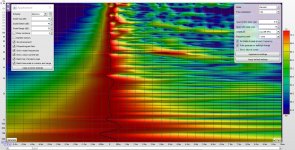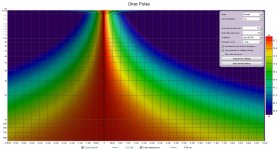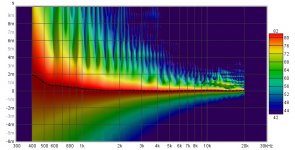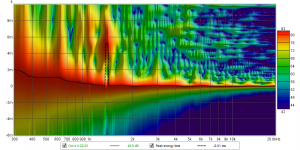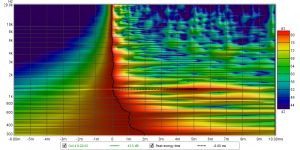Perhaps a 3D waterfall with time span of about 1.5ms would allow us see the waveguide reflections.
Just noticed all my charts above have different X axis. I'll try and keep to 20-20 and keep the Y same range also.
Just noticed all my charts above have different X axis. I'll try and keep to 20-20 and keep the Y same range also.
Do you know if there is an idiots guide to understanding what is the expectation in a wavelet spectrogram.
Or what ranges to use on the chart in order to see what needs to be seen? ;-)
I've attached two examples, one of a perfect Dirac Pulse (ideal impulse) and another of an in room measurement. Because the spectrogram is derived from the impulse applying an IR window as you would to gate out reflections won't make any difference. I prefer to look at it the other way round with frequency on the Y axis, you can use the limits box in conjunction with the controls in the spectrogram to change the view. I also like the rainbow 3D enhancement and turn the bands off.
It is a time vs frequency view so you can see when in time something happens and how long it goes on for.
The smoother the plot looks the better, the quicker it decays the better. Reflections or delayed resonances will show up where they appear in time and frequency.
This thread might give you some background, thread started by creator of APL_TDA, REW's spectrogram development was influenced by requests to have a view more like this software
The room correction or speaker correction? What can we do with dsp power now availabl
Attachments
That is also a good view, turn on the CSD mode to look at the early time information. You won't see much in the way of waveguide reflections with mabat's termination and a cabinet roundover.Perhaps a 3D waterfall with time span of about 1.5ms would allow us see the waveguide reflections.
That horn looks remarkably clean, here is my current setup to compare. It's a XT1464 with faital HF146 driver. You can see the diffraction issues clear as day in my setup. Looks to be non-existent in yours. You should set "amplitude: log (db SPL)" in the spectrogram settings btw.

Attachments
Last edited:
Perhaps a 3D waterfall with time span of about 1.5ms would allow us see the waveguide reflections.
Just noticed all my charts above have different X axis. I'll try and keep to 20-20 and keep the Y same range also.
"Standard" Y is 50 dB.
//
Should we open post your wavelet thread where are the rules with level (input volts?) measurement distances, who knows best names them?
As using wavequides 350hz above this interests me, and there is something going on.
As using wavequides 350hz above this interests me, and there is something going on.
Moved back upstairs in the room. Put some 50mm GK panels at first reflection points - not ideal. No EQ.
Attachments
Last edited:
skogs - i have that combo too - XT1464 with Faital HF146.
I'm struggling to find the correct trade-off between tonal balance and listening fatigue with this combo. I suspect it is because of the diffraction issues that gets hidden in normal frequency response measurements. There is supposedly a mismatch between the exit angle of the HF146 and the entry angle of the XT1464, it would be interesting to know if this is what we are seeing between 10khz and 20khz.
Have you considered designing a new waveguide for your HF146? Or are you happy with how it sounds on the XT1464? I suspect you would get less distortion in the low range on that driver.
I have designed a version of the same baffle/waveguide for the HF146 too that exhibits the the same simulated flat response curves. I thought I would try the HF10AK first as I had become acustomed and happy with the sound of the 146/1464. A journey to something different.
I tend to listen to this often during my testing. JW conducting Vienna Phil / Jurassic Park. It gives a good A/B for me.
John Williams & Vienna Philharmonic – Williams: Theme from “Jurassic Park” - YouTube
I tend to listen to this often during my testing. JW conducting Vienna Phil / Jurassic Park. It gives a good A/B for me.
John Williams & Vienna Philharmonic – Williams: Theme from “Jurassic Park” - YouTube
Last edited:
Hey kipman725, thanks! It is work in progress. I'm down in Nottingham. I might end up with a wood cabinet with a machined anodized aluminium wg and woofer ring.
B-52 PHRN-1014 10" x 14" Plastic Horn Waveguide | eBay this is the B-52 horn I have that looks a bit like your horn. Haven't done anything with it yet as big backlog of projects.
Another way of getting really good quality measurement data is to do a gated measurement but suspend the speaker from a cherry picker (or other tower) so you can get lower in frequency. The mic needs to be on another tower. Community light and sound got considerable competitive advantage in controlled directivty speakers for stadium usage by using this method so they could develop speakers that had controlled directivity lower in frequency. I think its also how Danley are measuring speakers.
With iteration 43 I believe I have removed more of the 0.5db waviness I had in the simulation (1k-10k) and also improved 9-15k flatness. This may improve reflection measurements but not too sure.
There looks to be a 1.2mm to 2.2mm surface deviation from iteration 39 that I tested and made above. I can fill the throat, pop back on the machine on the dowel pins and drop Z a little. Details to follow.
There looks to be a 1.2mm to 2.2mm surface deviation from iteration 39 that I tested and made above. I can fill the throat, pop back on the machine on the dowel pins and drop Z a little. Details to follow.
Last edited:
Should we open post your wavelet thread where are the rules with level (input volts?) measurement distances, who knows best names them?
As using wavequides 350hz above this interests me, and there is something going on.
Open post?
Simulation in post #1 set at 2.5m so I’ll aim for that mic distance. I’ve seen a few charts now that peak at 82dB. Would that be adequate for wavelet / reflection test? Do I let REW auto set axes or override to a “standard”?
“Time smear” is a term I’ve picked up regarding these wavelet charts.
A useful post
Using REW to Determine Time Delays Between Drivers - Technical/Modifications - The Klipsch Audio Community
Last edited:
I would use REW's alignment tool or 1/3 oct filter the two sides and match the waveshapes as shown here The making of: The Two Towers (a 25 driver Full Range line array) for setting relative crossover delays, the spectrogram is useful for showing if you got it right, but there are better tools within REW for crossover alignment.
Lots of other useful information in the post though 🙂
Lots of other useful information in the post though 🙂
I mean dedicated thread where people post their wavelets which could be comparable if measured under same rules
So this is sort of impulse matching what i was talking about earlier, amazingI would use REW's alignment tool or 1/3 oct filter the two sides and match the waveshapes as shown here The making of: The Two Towers (a 25 driver Full Range line array) for setting relative crossover delays, the spectrogram is useful for showing if you got it right, but there are better tools within REW for crossover alignment.
Lots of other useful information in the post though 🙂
Stereophile also have an intersting article regarding measurement.
Measuring Loudspeakers, Part Three Page 7 | Stereophile.com
Such as using charts dicussing vertical lobing / crossover point issues.
Measuring Loudspeakers, Part Three Page 7 | Stereophile.com
Such as using charts dicussing vertical lobing / crossover point issues.
Last edited:
That is a good read, thank you!
I am trying to stay at least 40db above the noise floor when measuring frequency response and wavelets. 82db is probably perfectly fine, unless you're in a very noisy area.
I am trying to stay at least 40db above the noise floor when measuring frequency response and wavelets. 82db is probably perfectly fine, unless you're in a very noisy area.
Setting up again tonight - I'll stick to 82db peak.
Also an interesting read
Validity of X-curve For Cinema Sound | Audio Science Review (ASR) Forum
Also an interesting read
Validity of X-curve For Cinema Sound | Audio Science Review (ASR) Forum
Last edited:
- Home
- Loudspeakers
- Multi-Way
- HF10AK + 12P80ND + custom WG
